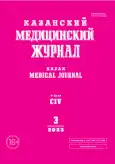Чресфистульные антеградные вмешательства в лечении доброкачественных билиарных стриктур
- Авторы: Ковалевский А.Д.1,2
-
Учреждения:
- Уральский государственный медицинский университет
- Городская клиническая больница №14
- Выпуск: Том 104, № 3 (2023)
- Страницы: 447-453
- Раздел: Обмен клиническим опытом
- Статья получена: 19.11.2022
- Статья одобрена: 16.02.2023
- Статья опубликована: 26.05.2023
- URL: https://kazanmedjournal.ru/kazanmedj/article/view/114729
- DOI: https://doi.org/10.17816/KMJ114729
- ID: 114729
Цитировать
Полный текст
Аннотация
Актуальность. Первичные реконструктивные операции, направленные на восстановление пассажа жёлчи, достаточно сложны из-за рубцового процесса и в 15–30% приводят к отдалённому рецидиву заболевания.
Цель. Представить результаты применения сочетанных рентгенохирургических и эндоскопических чресфистульных антеградных вмешательств в лечении доброкачественных стриктур жёлчных протоков.
Материал и методы исследования. За период с 2011 по 2019 г. на лечении в хирургических отделениях Городской клинической больницы №14 г. Екатеринбурга находился 31 пациент с доброкачественными стриктурами жёлчных протоков. Средний возраст больных составил 60,3±12,7 года, индекс коморбидности — 2,6. Как следует из представленных данных, у 13 пациентов стриктура развилась в области билио¬дигестивных анастомозов. Ещё у 17 больных стриктура возникла после операций по поводу желчнокаменной болезни. В 1 случае было стойкое сужение просвета холедоха на фоне индуративного панкреатита. В 25 (80,6%) случаях первым этапом выполнена чрескожная чреспечёночная холангиостомия под ультра¬звуковым контролем. Ещё у 6 (19,4%) пациентов был установлен Т-образный дренаж холедоха.
Результаты. Для лечения стриктур жёлчных протоков было выполнено 97 операций: в среднем 3,1 операции на 1 больного. Литоэкстракция проволочной корзинкой выполнена у 17 пациентов при наличии конкрементов. 5 больным с камнями более 10 мм потребовалась контактная литотрипсия. Стриктура подтверждена у 25 пациентов. В 21 случае выполнена баллонная дилатация. В 8 случаях дилатацию дополнили папиллосфинктеротомией. У 6 больных при деформации зоны анастомоза был установлен каркасный дренаж на 12 мес. У 3 пациентов выполняли билиодуоденальное стентирование нитиноловым стентом. Реканализировать стриктуру не удалось в 4 (13%) случаях. Осложнения зарегистрированы у 1 (3,2%) больного (IIIB степени по Clavien–Dindo).
Вывод. Чресфистульная холангиоскопия служит эффективной эндоскопической технологией в лечении больных с доброкачественными стриктурами жёлчных протоков.
Полный текст
Об авторах
Алексей Дмитриевич Ковалевский
Уральский государственный медицинский университет; Городская клиническая больница №14
Автор, ответственный за переписку.
Email: alexkov1968@mail.ru
ORCID iD: 0000-0002-2725-9130
канд. мед. наук, доц., каф. хирургии, колопроктологии и эндоскопии; зав. отд. лучевой диагностики
Россия, г. Екатеринбург, Россия; г. Екатеринбург, РоссияСписок литературы
- Майстренко Н.А., Ромащенко П.Н., Алиев А.К., Емельянов А.А., Феклюнин А.А. Хирургическое лечение ятрогенного повреждения желчевыводящих протоков. Вестник хирургии им. И.И. Грекова. 2016;175(3):83–85. EDN: VZUJPT.
- Nuzzo G, Giuliante F, Giovannini I, Ardito F, D’Acapito F, Vellone M, Murazio M, Capelli G. Bile duct injury during laparoscopic cholecystectomy: results of an Italian national survey on 56 591 cholecystectomies. Arch Surg. 2005;140(10):986–992. doi: 10.1001/archsurg.140.10.986.
- Гальперин Э.И., Чевокин А.Ю., Дюжева Т.Г. Факторы, определяющие выбор операции при «свежих» повреждениях магистральных жёлчных протоков. Анналы хирургической гепатологии. 2009;14(1):49–56. doi: 10.16931/1995-5464.2017319-28.
- Большая медицинская энциклопедия. В 30 т. Гл. ред. Б.В. Петровский. Акад. мед. наук СССР. 3-е изд. Т. 24. Москва: Советская энциклопедия; 1974–1989.
- Шалимов А.А., Копчак В.М., Сердюк В.П., Хомяк И.В., Дронов А.И. Рубцовые стриктуры жёлчных протоков: наш опыт хирургического лечения. Анналы хирургической гепатологии. 2000;5(1):85–89.
- Рыбачков В.В., Медведев А.М., Раздрогин В.А., Кирилюк А.А. Хирургическое лечение рубцовых стриктур внепечёночных жёлчных путей ятрогенного происхождения. Вестник Национального медико-хирургического центра им. Н.И. Пирогова. 2013;8(1):29–31. EDN: SIBYVR.
- Тарасенко С.В., Натальский А.А., Зайцев О.В., Песков О.Д., Афтаев В.Б., Луньков И.А., Марков О.В. Способ формирования тетрагепатикоеюноанастомоза при высокой стриктуре желчевыводящих путей. Хирургия. Журнал им. Н.И. Пирогова. 2013;(10):18-21. EDN: RTOZSV.
- Кулезнева Ю.В., Мелехина О.В., Курмансеитова Л.И., Ефанов М.Г., Цвиркун В.В., Алиханов Р.Б., Патрушев И.В. Pентгенохирургические методы лечения рубцовых стриктур билиодигестивных анастомозов: вопросы для дискуссии. Анналы хирургической гепатологии. 2017;22(3):45–54. doi: 10.16931/1995-5464.2017345-54.
- Lindquester WS, Prologo JD, Krupinski EA, Peters GL. Structured protocol for benign biliary anastomotic strictures: Impact on long-term clinical effectiveness. AJR Am J Roentgenol. 2018;210(2):447–453. doi: 10.2214/AJR.17.18236.
- Шаповальянц С.Г., Паньков А.Г., Мыльников А.Г., Будзинский С.А., Орлов С.Ю. Возможности эндоскопического билиодуоденального протезирования в лечении опухолевых и рубцовых стриктур внепечёночных жёлчных протоков. Российский журнал гастроэнтерологии, гепатологии, колопроктологии. 2008;(6):57–64.
- Zepeda GS, Baron TN. Benign biliary strictures: current endoscopic management. Nat Rev Gastroenterol Hepatol. 2011;8(10):573–581. doi: 10.1038/nrgastro.2011.154.
- Kucukay F, Okten RS, Yurdakul M. Long-term results of percutaneous biliary balloon dilation treatment for benign hepaticojejunostomy strictures: Are repeated balloon dilations necessary? J Vasc Interv Radiol. 2012;23(10):1347–1355. doi: 10.1016/j.jvir.2012.07.004.
- Охотников О.И., Яковлева М.В., Григорьев С.Н. Антеградные эндобилиарные вмешательства при нерасширенных жёлчных протоках. Хирургия. Журнал им. Н.И. Пирогова. 2016;(12):42–47. doi: 10.17116/hirurgia20161242-47.
- Ramos-De La Medina A, Misra S, Leroy AJ, Sarr MG. Management of benign biliary strictures by percutaneous interventional radiologic techniques (PIRT). HPB (Oxford). 2008;10:428–432. doi: 10.1080/13651820802392304.
- Im BS, Gwon DI, Chu HH, Kim JH, Ko GY, Yoon HK. Percutaneous transhepatic treatment of benign bile duct strictures using retrievable covered stents: Long-term outcomes in 148 patients. Korean J Radiol. 2022;23(9):889–900. doi: 10.3348/kjr.2022.0204.
- Thomas RP, Köcher M. Percutaneous treatment of benign biliary strictures and biliary manometric perfusion test. Biomed Pap Med Fac Univ Palacky Olomouc Czech Repub. 2007;151(1):85–90. doi: 10.5507/bp.2007.015.
Дополнительные файлы









